Welcome to the ultimate Labrador Retriever training guide, where you’ll find everything you need to know to raise a happy and obedient dog. This comprehensive resource covers all aspects of training, from basic obedience to troubleshooting common behavioral problems. With step-by-step instructions and expert advice, you’ll be equipped with the knowledge and techniques to ensure your Labrador Retriever becomes a well-behaved and cherished companion.
- Comprehensive resource covering all aspects of Labrador Retriever training.
- Step-by-step instructions and expert advice for successful training sessions.
- Emphasizes positive reinforcement and modern training methods.
- Includes information on understanding Labrador body language.
- Troubleshoots common behavioral problems.
Labrador Retriever Training Tips for Success
Discover essential Labrador Retriever training tips that will set you on the path to success. Training your Labrador Retriever is an important part of raising a well-behaved and happy dog. These training tips cover a range of topics and techniques to help you establish a strong bond with your furry friend and ensure their obedience.
1. Start with Positive Reinforcement: Labrador Retrievers are highly motivated by rewards, so be sure to use positive reinforcement techniques such as treats, praise, and playtime to reinforce good behavior. This will encourage your Labrador to repeat desirable actions and make the training process more enjoyable for both of you.
2. Be Consistent: Consistency is key when it comes to training your Labrador Retriever. Establish clear rules and expectations from the beginning and stick to them. Use the same commands and gestures consistently, and ensure that all family members are on board with the training routine. This will help your Labrador understand what is expected of them and avoid confusion.
3. Keep Training Sessions Short and Fun: Labrador Retrievers have a short attention span, so keep your training sessions brief and enjoyable. Aim for multiple short sessions throughout the day rather than one long session. This will help prevent your Labrador from getting bored or overwhelmed. Incorporate games and interactive exercises into the training to make it more engaging for your dog.
Labrador Retriever Training Tips Infographic:
| Training Tip | Description |
|---|---|
| Use Positive Reinforcement | Reward your Labrador Retriever with treats, praise, and playtime for good behavior. |
| Be Consistent | Establish clear rules and expectations and ensure everyone in the family follows them. |
| Keep Sessions Short and Fun | Engage your Labrador with interactive exercises and keep training sessions brief to maintain their focus. |
By following these Labrador Retriever training tips, you’ll be well-equipped to train your dog effectively and cultivate a strong bond. Remember, patience and positive reinforcement are key when it comes to training your Labrador Retriever. Enjoy the process and celebrate the progress you and your furry friend make together.
Labrador Retriever Puppy Training Basics
Start your Labrador Retriever’s training journey right with our comprehensive puppy training basics. Training a Labrador Retriever puppy is an essential step in raising a well-behaved and happy dog. Our guide covers the fundamental aspects of puppy training, equipping you with the knowledge and techniques to lay a solid foundation for your furry friend’s future.
Potty Training
One of the first and most important lessons to teach your Labrador Retriever puppy is potty training. Establishing a consistent routine and rewarding positive behavior is key to successful housebreaking. Use positive reinforcement, such as treats or verbal praise, to encourage your puppy to eliminate in designated areas. Be patient and consistent, and remember that accidents may happen during the learning process.
To keep track of your puppy’s progress, create a potty training schedule and mark successful bathroom breaks on a chart. This visual aid will help you identify patterns and adjust the routine as needed. Remember to provide plenty of opportunities for your puppy to go outside, especially after meals, naps, and playtime.
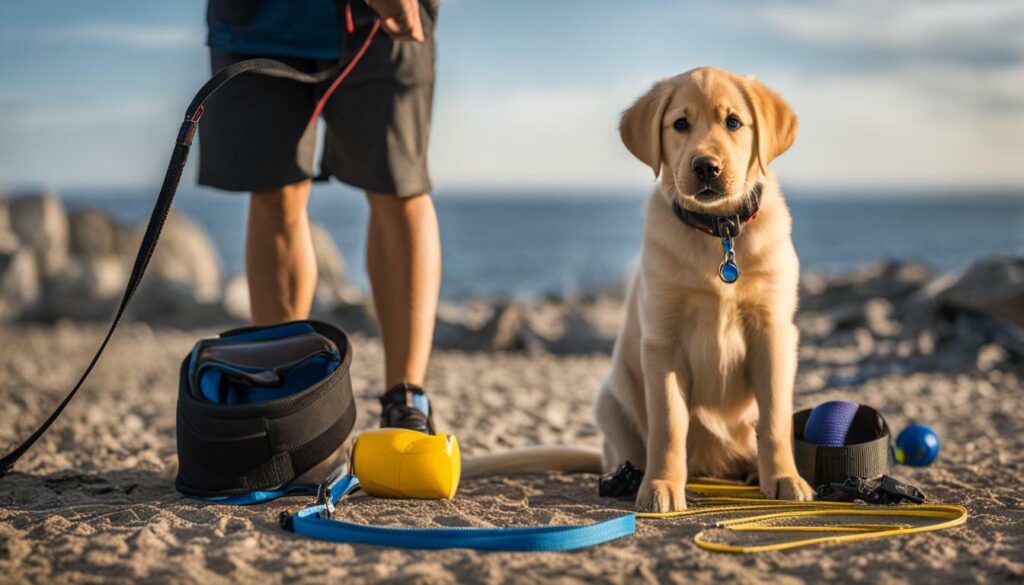
Introducing the Crate
The crate can be a valuable tool in Labrador Retriever puppy training. It serves as a safe space for your puppy and aids in housebreaking and preventing destructive behavior when you cannot supervise them. Introduce the crate gradually, making it a positive and comfortable environment. Place soft bedding, toys, and treats inside to entice your puppy to enter willingly.
Start with short periods of confinement, gradually increasing the duration as your puppy becomes more comfortable. Use positive reinforcement, such as praise and treats, to reward calm behavior inside the crate. Avoid using the crate as a form of punishment, as this can create negative associations.
Teaching Bite Inhibition
Puppies explore the world with their mouths, often leading to biting and nipping behaviors. Teaching bite inhibition is crucial to ensure your Labrador Retriever doesn’t inadvertently hurt others or become a mouthy adult dog. When your puppy bites or nips, redirect their attention to a suitable chew toy and provide positive reinforcement when they engage with it.
Encourage gentle play and discourage rough behavior by yelping or saying “ouch” when your puppy bites too hard. This mimics how their siblings would react during play. If your puppy continues to bite, take a short time-out by removing your attention. Consistency and patience are essential in teaching bite inhibition.
| Labrador Retriever Puppy Training Basics | |
|---|---|
| Potty Training | Create a consistent routine and reward positive behavior. Use a chart to track progress. |
| Introducing the Crate | Make the crate a positive environment with treats and toys. Gradually increase confinement duration. |
| Teaching Bite Inhibition | Redirect biting to appropriate chew toys. Encourage gentle play and use time-outs if necessary. |
Establishing Obedience: Labrador Retriever Training Techniques
Take your Labrador Retriever’s obedience to the next level with these proven training techniques. Establishing obedience is an essential part of raising a well-mannered and happy dog. By using positive reinforcement and modern training methods, you can effectively teach your Labrador Retriever commands, improve their behavior, and strengthen your bond.
One of the key techniques in Labrador Retriever obedience training is using rewards to reinforce desired behavior. Whether it’s treats, praise, or playtime, rewards serve as powerful motivators. When your dog follows a command correctly, immediately reward them to reinforce that behavior. This positive reinforcement helps your Labrador Retriever associate good behavior with pleasant outcomes, making them more likely to repeat it in the future.
In addition to rewards, consistency is crucial when training your Labrador Retriever. Use the same commands, cues, and gestures consistently so your dog can understand and respond appropriately. Consistency also applies to your expectations and rules. Set clear boundaries and enforce them consistently to prevent confusion and promote good behavior.
Training Techniques Summary:
- Use positive reinforcement, such as treats and praise, to reward desired behavior.
- Be consistent with your commands, cues, and rules.
- Establish clear boundaries and enforce them consistently.
Remember, training takes time and patience. Each dog is unique, so it’s important to adapt your approach to fit your Labrador Retriever’s individual needs and personality. If you encounter challenges along the way, don’t get discouraged. Seek the guidance of professional trainers or consider enrolling in obedience classes. With dedication and the right training techniques, you can raise a well-behaved and obedient Labrador Retriever.
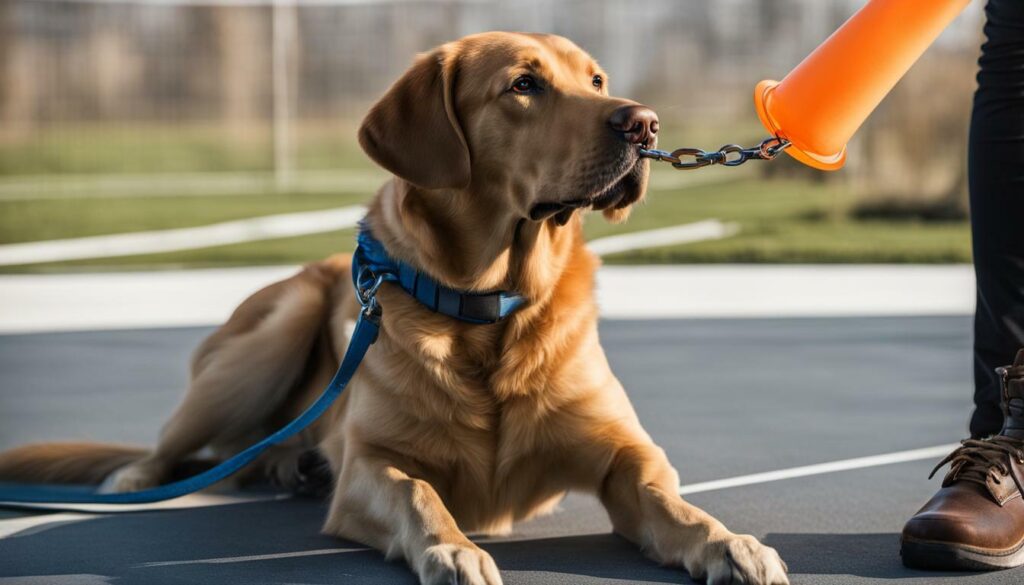
| Training Techniques | Benefits |
|---|---|
| Positive reinforcement | Encourages desired behavior and strengthens the bond between you and your Labrador Retriever. |
| Consistency | Helps your dog understand and respond to commands consistently, reducing confusion and promoting good behavior. |
| Clear boundaries | Establishing clear rules and boundaries helps your Labrador Retriever understand what is expected of them, leading to better obedience. |
Understanding Labrador Retriever Behavior: Body Language and Communication
Gain a deeper understanding of Labrador Retriever behavior through their body language and communication cues. As a Labrador Retriever owner, it’s essential to be able to interpret your dog’s signals to better understand their needs and emotions. By recognizing their body language and communication cues, you can establish a stronger bond with your furry friend and address behavioral issues more effectively.
Labrador Retrievers use their body language to express a wide range of emotions. For example, a wagging tail typically indicates happiness and excitement, while a tucked tail suggests fear or anxiety. Pay attention to their ears, as pricked ears often indicate attentiveness, while flattened ears may signify submission or unease. Understanding these subtle cues allows you to gauge your dog’s emotional state and respond accordingly.
Communication cues, such as barking, growling, and whining, also offer insights into your Labrador Retriever’s needs. Barking can signify various things, including boredom, playfulness, or alerting you to potential dangers. Growling is a warning sign and often indicates discomfort or aggression, while whining can express anxiety or a desire for attention. By paying attention to these vocalizations, you can better meet your dog’s needs.
Body Language and Communication Table
| Behavior | Meaning |
|---|---|
| Wagging tail | Happiness and excitement |
| Tucked tail | Fear or anxiety |
| Pricked ears | Attentiveness |
| Flattened ears | Submission or unease |
| Barking | Boredom, playfulness, or alerting |
| Growling | Discomfort or aggression |
| Whining | Anxiety or a desire for attention |
Understanding Labrador Retriever behavior goes beyond body language and vocal cues. It also involves recognizing their individual personality traits and preferences. Some Labrador Retrievers may be more outgoing and friendly, while others can be shy or reserved. By observing their behavior in different situations and environments, you can tailor their training and socialization to meet their specific needs.
By investing time in understanding your Labrador Retriever’s behavior, you’ll develop a stronger connection with your four-legged companion. Remember to always approach training and behavior management with patience, consistency, and positive reinforcement. With a deep understanding of Labrador Retriever behavior, you can foster a loving and harmonious relationship that lasts a lifetime.
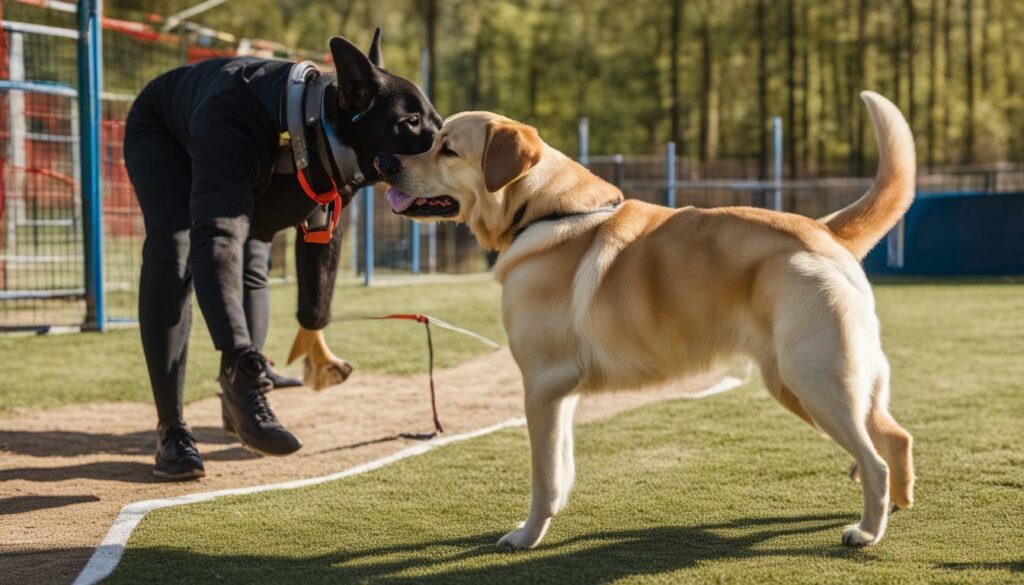
Don’t let common behavioral problems derail your Labrador Retriever’s training progress – discover effective solutions here. Labrador Retrievers are known for their friendly and loyal nature, but like any dog, they can occasionally display unwanted behaviors. Whether it’s excessive barking, jumping on visitors, or separation anxiety, these issues can be frustrating for both you and your furry friend. Fortunately, with the right approach and consistent training, you can address these problems and foster a harmonious relationship with your Labrador Retriever.
Excessive Barking
One of the most common behavioral problems Labrador Retrievers face is excessive barking. Barking is a natural form of communication for dogs, but when it becomes excessive, it can be disruptive and bothersome. To tackle this issue, it’s important to identify the cause of the barking. Is your Labrador Retriever bored, anxious, or alerting you to something? Once you pinpoint the underlying reason, you can address it through training techniques such as positive reinforcement, redirection, and providing mental and physical stimulation.
Jumping on Visitors
Another common behavior problem in Labrador Retrievers is jumping on visitors. While it may seem like an innocent display of excitement, it can be overwhelming and even dangerous, especially for children or the elderly. To prevent this behavior, it’s essential to teach your Labrador Retriever an alternative greeting, such as sitting calmly when guests arrive. Consistency and positive reinforcement training methods can help your dog learn that calm behavior is rewarded, while jumping is not.
Separation Anxiety
Labrador Retrievers are known for their loyalty, and as a result, they can be prone to separation anxiety. This condition manifests when your dog becomes distressed or anxious when left alone. Symptoms of separation anxiety may include excessive barking, destructive behavior, or house-soiling. To address this issue, it’s crucial to gradually accustom your Labrador Retriever to being alone through crate training, desensitization techniques, and providing mental stimulation for when you’re not around. Consulting a professional dog trainer or behaviorist can also provide valuable guidance in managing separation anxiety.
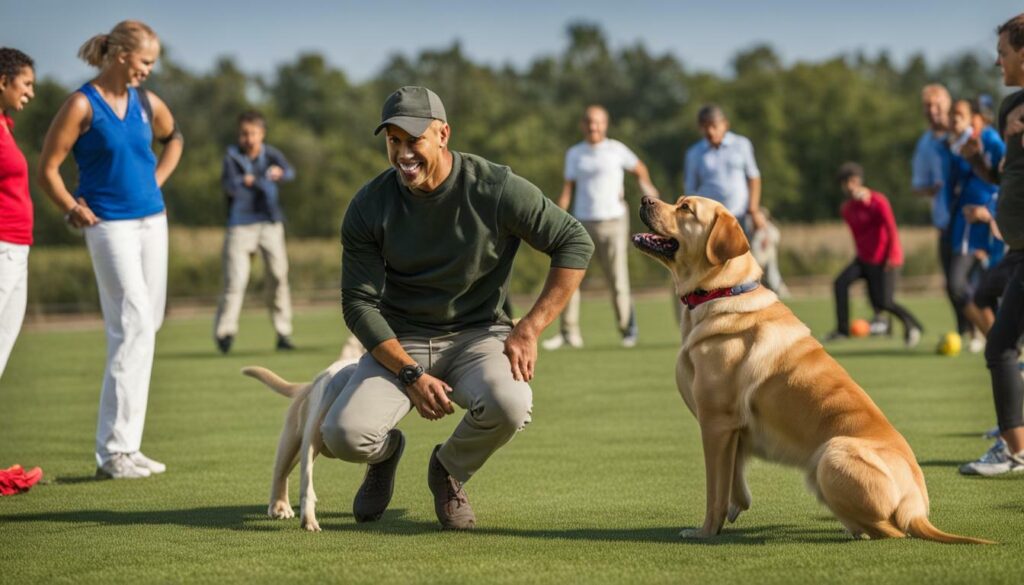
In conclusion, behavioral problems in Labrador Retrievers can be effectively addressed through consistent training, patience, and understanding. By identifying the underlying causes of these behaviors and implementing positive reinforcement techniques, you can transform your Labrador Retriever into a well-behaved and happy companion. Remember to seek professional advice if needed and always approach training with kindness and respect towards your furry friend.
Labrador Retriever Crate Training: Creating a Safe Space
Learn the ins and outs of Labrador Retriever crate training to provide your dog with a safe and soothing retreat. Crate training is an essential part of raising a well-behaved and happy Labrador Retriever. By introducing the crate properly and using positive reinforcement techniques, you can create a secure environment that your dog will love.
When starting crate training, it’s important to choose the right crate size for your Labrador Retriever. The crate should be spacious enough for your dog to stand, turn around, and lie down comfortably. However, avoid selecting a crate that is too large as it may encourage your dog to use one corner for sleeping and the other for eliminating.
Make the crate inviting by placing comfortable bedding and a few toys inside. This will help create a positive association with the crate and make it a pleasant space for your Labrador Retriever. Remember to praise and reward your dog when they voluntarily enter the crate, helping them understand that it is a rewarding and safe place to be.
| Labrador Retriever Crate Training Tips |
|---|
| Start with short crate sessions, gradually increasing the duration over time. |
| Never use the crate as a form of punishment. It should always be associated with positivity. |
| Do not let your dog out of the crate if they are whining or barking. Wait for a moment of calmness before opening the door. |
| Use a command or cue, such as “crate” or “go to bed,” to teach your dog to enter the crate willingly. |
| Gradually increase the distance between the crate and yourself to help your dog become comfortable being alone in the crate. |
| Consult with a professional trainer if your Labrador Retriever exhibits signs of anxiety or resistance to crate training. |
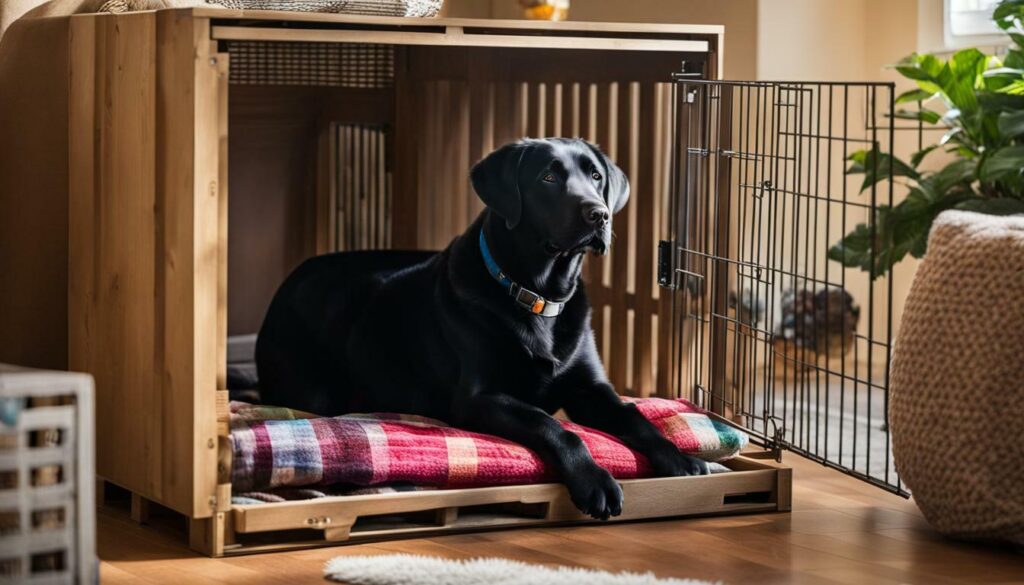
During Labrador Retriever crate training, it’s important to avoid common mistakes that can hinder your dog’s progress. One common mistake is using the crate as a forced confinement tool. The crate should never be used to isolate or punish your dog. Instead, it should be a positive and comforting space for them.
Another mistake to avoid is rushing the training process. Gradual progress is key when crate training. Start with short periods of time in the crate and gradually increase the duration to help your Labrador Retriever feel more comfortable. Patience and consistency are crucial for successful crate training.
Lastly, avoid using the crate as a solution for excessive barking or separation anxiety. Addressing these behavioral issues requires a comprehensive training plan and professional guidance. Using the crate as a temporary fix may worsen the problem and create negative associations with the crate.
By following these tips and avoiding common mistakes, you can create a safe and soothing space for your Labrador Retriever. Crate training not only provides a secure retreat for your dog, but it also helps with housebreaking, prevents destructive behaviors, and eases travel or vet visits. Invest time and effort into crate training, and you’ll reap the rewards of a well-adjusted and contented Labrador Retriever.
Leash Training: Walking Your Labrador Retriever with Confidence
Discover the key to successful leash training and enjoy confident walks with your Labrador Retriever. Leash training is a crucial aspect of your dog’s obedience and safety, allowing you to have control and establish boundaries during walks. With consistent training and positive reinforcement, you can ensure that your Labrador Retriever walks politely by your side, making every walk an enjoyable experience for both of you.
When starting leash training, it’s essential to choose the right leash and collar or harness for your Labrador Retriever. A standard leash length of 4 to 6 feet provides the right amount of control while giving your dog some freedom to explore. Opt for a collar or harness that fits well and doesn’t restrict your dog’s movement or breathing. Remember, comfort is key to successful training.
To begin the training process, start in a quiet and distraction-free environment, such as your backyard or a calm park. Use positive reinforcement techniques, rewarding your Labrador Retriever with treats and praise for walking calmly by your side and following your cues. Start with short training sessions, gradually increasing the duration as your dog becomes more comfortable and responsive.
During walks, be consistent with your commands and expectations. Use simple and clear verbal cues, such as “heel” or “walk,” to let your Labrador Retriever know what you expect from them. Reward your dog for good behavior, such as walking without pulling or lunging, and redirect their attention if they become distracted or start to pull. With patience and consistency, your Labrador Retriever will learn to walk politely on a leash and enjoy stress-free walks with you.

- Start leash training as early as possible to establish good habits from the beginning.
- Use positive reinforcement, rewarding your Labrador Retriever with treats, praise, and encouragement.
- Be patient and consistent with your training, practicing regularly and gradually increasing the difficulty level.
- Avoid pulling on the leash or yanking your dog, as this can cause discomfort and lead to negative associations with walking.
- Practice loose leash walking, where the leash remains relaxed and there is no tension between you and your dog.
- If your Labrador Retriever pulls or becomes overly excited, stop walking and wait for them to calm down before continuing.
| Benefits of Leash Training: |
|---|
| Improved control during walks |
| Enhanced safety for your dog and others |
| Opportunity for mental and physical stimulation |
| Strengthened bond between you and your Labrador Retriever |
Taking Labrador Retriever Training to the Next Level
Ready to take your Labrador Retriever’s training to a whole new level? Explore these advanced techniques and watch your dog thrive. As your Labrador matures and becomes more confident in their basic training, it’s time to challenge their intellect and physical abilities with advanced training exercises.
One popular avenue for advanced training is agility training. Not only does it provide mental stimulation, but it also builds your Labrador’s physical endurance and coordination. Set up an agility course in your backyard or find local clubs that offer classes. Your Labrador will love running through tunnels, jumping over obstacles, and navigating weave poles.
If you’re looking to impress your friends with your Labrador’s skills, dive into advanced tricks training. Teach your dog impressive tricks like playing dead, spinning in circles, or giving high fives. These tricks not only provide mental stimulation but also strengthen the bond between you and your Labrador.
When embarking on advanced training, it’s important to remember the principles that have made your Labrador successful thus far. Continue to use positive reinforcement techniques, such as treats and praise, to reward desired behaviors. Patience and consistency are key, as some advanced skills may take time for your Labrador to master.
FAQ
What topics does the Ultimate Labrador Retriever Training Guide cover?
The guide covers topics such as potty training, crate training, teaching a puppy not to bite, training a dog to come and sit, and early obedience training.
Does the guide emphasize positive reinforcement?
Yes, the guide emphasizes the importance of positive reinforcement and modern training methods.
Is there practical advice from expert trainers included in the guide?
Yes, the guide offers practical tips and advice from expert trainers.
Does the guide include information on understanding Labrador body language?
Yes, the guide includes information on understanding Labrador body language and communication.
Are troubleshooting common behavioral problems addressed in the guide?
Yes, the guide includes information on troubleshooting common behavioral problems in Labrador Retrievers.
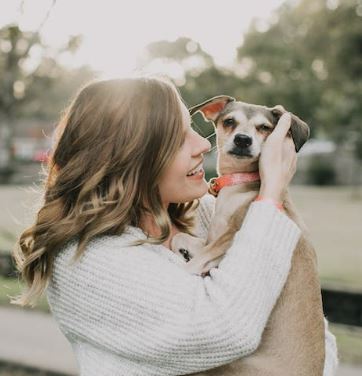
Marissa Delotta, 36, from Dayton, Ohio, is the creative force behind Roverboard.com, a beloved online destination for dog lovers. As a dedicated mom and canine enthusiast, Marissa combines her family experiences with her love for dogs to offer a platform where dog owners can exchange tips, heartwarming stories, and advice. Her website has become a vibrant community for sharing the joys of dog parenting. In her free time, Marissa enjoys exploring dog parks with her family and volunteering at local animal shelters.